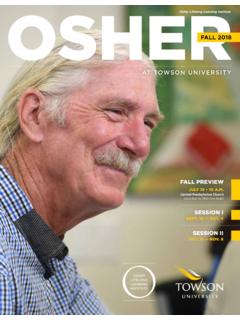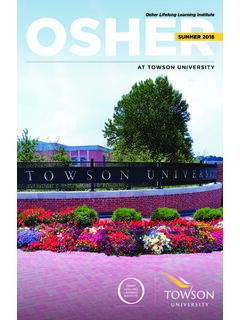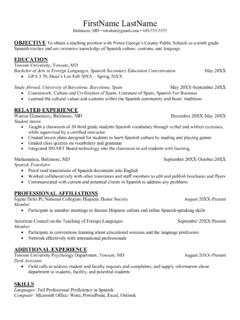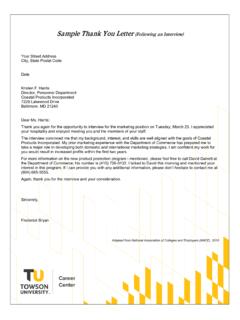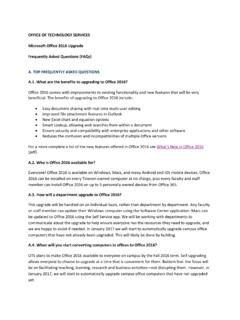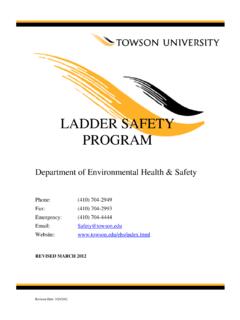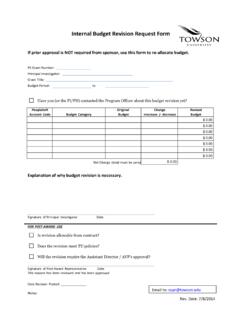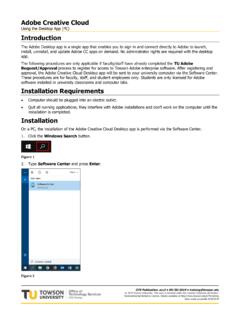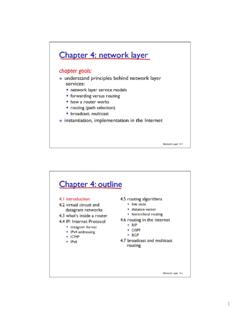Transcription of DNA Extraction Lab - Towson University
1 Meischer s Discovery A DNA Extraction Laboratory Maryland Loaner Lab Teacher Packet Written and developed by Towson University & TIGR. Version 01-04-2012_dp 1 | P a g e T E A C H E R M A T E R I A L S Maryland Loaner Lab Overview 2 Maryland Science Core Learning Goals 3 Meischer s Discovery: Introduction 5 Pre-Laboratory Activity: Making a Cell 8 Laboratory Explanation 10 Teacher Laboratory Preparation 12 S T U D E N T A C T I V I T Y H A ND O U T S Laboratory Protocol S-1 MARYLAND LOANER LAB OVERVIEW 2 | P a g e Meischer s Discovery has two parts: A classroom pre-laboratory activity that introduces the concept of the cell and DNA. A DNA isolation laboratory activity that allows students to extract and visualize DNA from different types of cells (plant and animal) with an introduction to scientific procedures. Teachers and students who will be performing the Meischer s Discovery laboratory activity must first complete the pre-laboratory classroom activity.
2 The conceptual aspects of the curriculum will be reinforced with the laboratory activity. Supplied By Maryland Loaner Lab: (for one class with ten stations) Description Quantity Comments Must be Returned Pipette pumps 10 Pump used with pipettes to measure liquids Return Plastic pipettes: -10 DNA Buffer -10 Alcohol -10 Experimental -10 dH2O 40 Size: 10 ml; Each student group needs 4 pipettes one of each Clean, dry and return Salmon cells + 2 tubes Each group gets 2 ml in + tube (Keep refrigerated) Clean, dry and return DNA Buffer 10 tubes 8 ml per DNA Buffer tube, 1 for each group Clean, dry and return Empty 15 ml alcohol tubes 10 tubes Fill with 8 ml of alcohol, 1 for each group Clean, dry and return Distilled water (dH2O) tubes 10 tubes 10 ml per tube, 1 for each group Clean, dry and return Wooden sticks 10 1 for each group Return unused only Capped test tubes 30 (empty tubes) 3 for each student group E & - & + Clean, dry and return Container Disinfectant Wipes 1 Return Supplied By Teacher: Description Quantity Comments Fruit/Vegetable varies Per student group - of a medium or large strawberry, -inch slice of banana, of a kiwi or the equivalent Isopropyl or Ethyl Alcohol (70%) 80 ml per class 8 ml per group.
3 Best if used chilled. Note: 70% isopropyl or ethyl alcohol will work, but 90% is preferred. Zip-lock bag 10 1 for each group to prepare experimental sample Cheesecloth Roll of cloth (Optional) for straining solid particles of fruit/vegetable during Extraction . Test tube racks 10 1 per group Beaker or cup 10 1 per group. Small in size, to hold approximately 20 ml. IMPORTANT: The teacher must also supply all the materials for the Pre-Lab Activity found on page 8 if they wish to perform this activity with their students. SAFETY: The classroom teacher must instruct students about basic laboratory safety rules and provide gloves and goggles for student use with the laboratory activity. These classroom and laboratory activities meet several of the Maryland Science Content Standards: Goal Skills and Processes Use analyzed data to confirm, modify, or reject a hypothesis.* The student will identify meaningful, answerable scientific questions. student will pose meaningful answerable scientific questions.
4 The student will formulate a working hypothesis. student will test a working hypothesis. The student will identify appropriate methods for conducting an investigation (independent and dependent variables, proper controls, repeat trials, appropriate sample size, etc. student will develop and demonstrate skills in using lab and field equipment to perform investigative techniques. ** The student will recognize safe laboratory procedures. ** student will demonstrate safe handling of the chemicals and materials of science. ** The student will learn the use of new instruments and equipment by following instructions in a manual or from oral direction. ** The student will demonstrate the ability to summarize data (measurements/observations). Students will investigate career possibilities in the various areas of science. ** Goal Concepts of Biology The student will be able to describe the unique characteristics of chemical substances and macromolecules utilized by living systems.)
5 (specifically DNA)* * Italicized CLG s are the primary focus of the laboratory activity. The other indicators are addressed, but can also be used as a guide to determine the focus of the lesson plans for the pre-lab and post-lab extension activities. ** All labs include all assessment limits/indicators for Goal 1. Expectation 3: The student will carry out scientific investigations effectively and employ the instruments, systems of measurement, and materials of science appropriately. ** The provided DVD, MdBio Tech Council of Maryland, Careers in Biotechnology addresses 3| P a g e DNA Exploration Middle School VSC 1. : Design, analyze, or carry out simple investigations and formulate appropriate conclusions based on data obtained or provided. 1. : Explain and provide examples that all hypotheses are valuable, even if they turn out not to be true, if they lead to fruitful investigations. 1. : Review data from a simple experiment, summarize the data, and construct a logical argument about the cause and effect relationship in the experiment.
6 1. : Describe the reasoning that lead to the interpretation of data and conclusions drawn. 4| P a g e MEISCHER S DISCOVERY: INTRODUCTION 5 | P a g e This DNA Extraction laboratory is an activity to facilitate learning about cells and the structures inside of them. All living things are made of cells. Inside cells are smaller structures called organelles that work to perform different functions, or jobs, within the cell. Included are a pre-laboratory activity to aid in understanding organelle functions and a laboratory activity in which students will isolate and observe DNA from two types of cells. Background Information All living things are made of cells. Cells are the basic unit of life and make up all plants, animals and bacteria. In plants and animals, cells often work together to form tissues; groups of these tissues are called organs. For example, heart cells make up heart tissue, which in turn makes up the organ called the heart.
7 The cells in your heart work together to push red blood cells through your body. Red blood cells carry oxygen to all parts of your body and oxygen is used to produce energy so your body can survive. Inside cells are smaller structures called organelles. These tiny structures act like factories that help the cell perform certain tasks such as general repairs, removing waste, and reproduction. The three main parts of the cell are the nucleus, which holds DNA, the cell membrane, which surrounds and protects the cell, and the cytoplasm, which is the jelly-like part of the cell between the membrane and the nucleus. All of the smaller organelles, such as mitochondria, are found in the cytoplasm. Cell Part Function in the Cell Cell Membrane Security guard: checks what goes in and out of the cell Mitochondria Powerhouses: generates energy for the cell Membrane Receptors Gather information and deliver it to the nucleus Nucleus The brain or control center for the cell DNA Contains instructions for the cell, found in the nucleus Deoxyribonucleic acid or DNA is the molecule that controls everything that happens in the cell.
8 DNA contains the genetic code or commands that direct the MEISCHER S DISCOVERY: INTRODUCTION 6 | P a g e activities of cells and ultimately, the body. DNA is present in all living things from bacteria to animals. In animals, it is found in almost all cell types except for usually in red blood cells. DNA is made of two spiral strands that wind around each other like a twisted ladder. The rungs of the ladder are made up of nucleotides: adenine (A), thymine (T), cytosine (C), and guanine (G). These nucleotides pair together: adenine with thymine and cytosine with guanine. These A-T and C-G pairs make up the rungs of the ladder. The different nucleotides are like a four-letter alphabet and can spell out different words or codes. A gene is a long series of the four letters (nucleotides) that contains instructions for the cell to make a particular protein. DNA is the largest known molecule.
9 A single unbroken strand can contain millions of atoms. When DNA is released from a cell it typically breaks up into tiny fragments. These tiny fragments have a slightly negative electric charge. Salt ions, common in many solutions, are attracted to the negative charges on the DNA fragments and prevent them from adhering to one another. By controlling the salt concentration of the solution containing the DNA fragments, DNA can remain fragmented or become very sticky and form large globs of molecular material. Since DNA is an essential molecule to all living things (with the exception of some viruses), it is not surprising that elaborate mechanisms to protect it have evolved . In order to extract DNA successfully, it is helpful to understand these protective mechanisms. The simplest organisms do not have the protection of a nucleus; this group of organisms is called prokaryotes.
10 Common prokaryotes are bacteria. The DNA of bacteria floats around in the cytoplasm and is protected from invading viral DNA by restriction enzymes that can cut foreign DNA into small pieces. So how do the bacteria prevent their own DNA from being digested by these enzymes? The bacterial DNA has chemical groups called methyl groups attached to it which prevents the restriction enzymes from cutting it. Bacteria have a relatively simple protection mechanism. As organisms get more complex, so does the protection of their own DNA. Eukaryotic organisms keep their DNA contained within a nucleus, protecting it from activities going on in the cytoplasm. Plants have the extra protection of a cell wall. All eukaryotes have DNAse enzymes floating around in their cytoplasm that can cut DNA. In order to extract spoolable DNA, it is necessary to denature, or breakdown, these enzymes before rupturing the nucleus.

